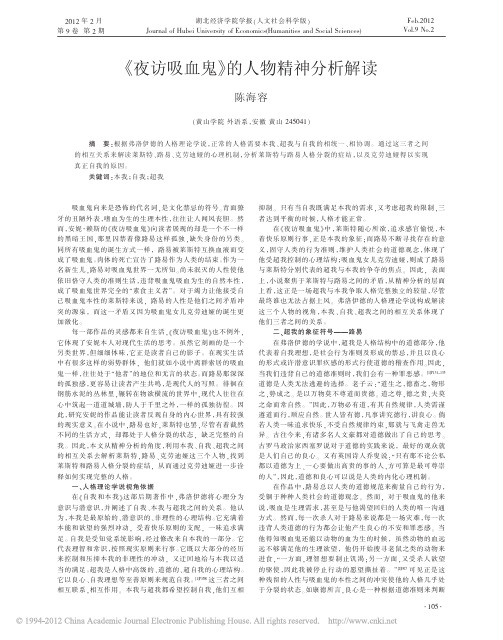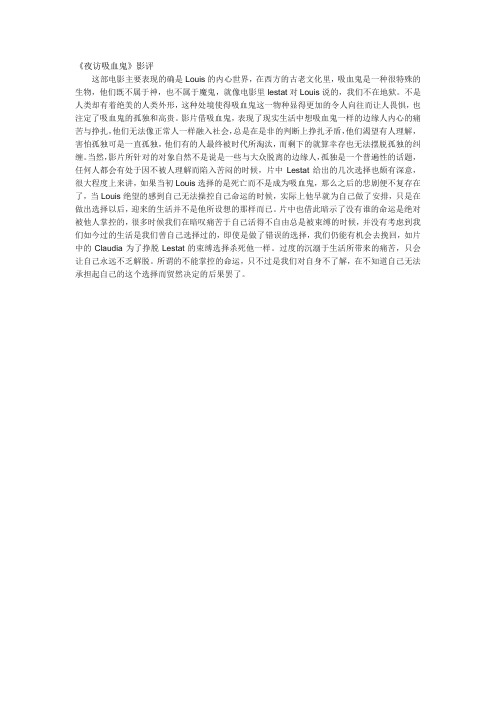《夜访吸血鬼》中吸血鬼形象的象征主义分析
- 格式:pdf
- 大小:176.46 KB
- 文档页数:2

夜访吸血鬼观后感吸血鬼传奇中的爱与永生夜访吸血鬼观后感:吸血鬼传奇中的爱与永生夜色中的血色,迷离而诱人。
在吸血鬼的世界中,爱与永生是主题重要的元素之一。
《夜访吸血鬼》一书中,作者安妮·赖斯以其独特的写作风格,让我们深入探索了吸血鬼的传奇,同时也揭示了其中蕴含的爱与永生的复杂关系。
小说的故事背景设定在18世纪的路易斯安那州,主人公路易斯成为了一个吸血鬼。
书中通过他的视角,深入刻画了吸血鬼们独特而诱人的气质,以及他们与人类之间纠葛的爱恨情仇。
在这个世界中,爱意味着不再有死亡的恐惧,在永生中找到彼此的陪伴和依靠。
而永生则象征着无尽的时光和无法逃脱的痛苦。
故事中最引人注目的爱情线索应该是路易斯与他的导师列斐斯特之间的关系。
初遇时,列斐斯特的神秘和强大吸引了路易斯,使他毫不犹豫地选择成为吸血鬼。
然而,随着时间的流逝,路易斯开始对吸血鬼的存在和他与列斐斯特之间的关系产生怀疑。
他逐渐意识到吸血鬼世界的黑暗和痛苦,并开始反抗列斐斯特的统治。
这种复杂的情感冲突使得他对爱与永生的认知发生了深刻的变化。
在小说中,爱被描绘得鲜活而真实。
路易斯被压抑的爱情所困扰,他无法忘记已故妻子的容貌和情感。
在邂逅了年轻而美丽的女吸血鬼克劳迪娅后,路易斯的内心陷入痛苦的纠结。
他对克劳迪娅的爱意味着对先前妻子的背叛,而对于一个永生的存在来说,这种背叛所造成的后果无异于折磨。
爱情成为路易斯心底最柔软的部分,在吸血鬼的世界中表现得异常脆弱。
然而,小说也揭示了爱与永生之间的冲突和矛盾。
虽然永生给予吸血鬼们无尽的可能性和力量,但它也带来了灵魂上的压抑和孤独感。
吸血鬼们注定要见证自己所爱的人一一离去,而他们自己却一直留在世间。
这种情感上的割裂使得他们在得到永生的同时也不可避免地感受到了永世的痛苦。
爱总是和死亡紧密相连,在吸血鬼的世界中更是如此。
通过《夜访吸血鬼》,我们看到了爱与永生之间如同两面银币般的矛盾和联系。
吸血鬼们以爱情为动力,寻找着情感的安慰和温暖。


第9卷第2期2012年2月Journal of Hubei University of Economics(Humanities and Social Sciences)湖北经济学院学报(人文社会科学版)Feb.2012Vol.9No.2吸血鬼向来是恐怖的代名词,是文化禁忌的符号。
青面獠牙的丑陋外表,嗜血为生的生理本性,往往让人闻风丧胆。
然而,安妮·赖斯的《夜访吸血鬼》向读者展现的却是一个不一样的黑暗王国,那里囚禁着像路易这样孤独,缺失身份的另类。
同所有吸血鬼的诞生方式一样,路易被莱斯特互换血液而变成了吸血鬼。
肉体的死亡宣告了路易作为人类的结束。
作为一名新生儿,路易对吸血鬼世界一无所知。
尚未泯灭的人性使他依旧恪守人类的准则生活,违背吸血鬼吸血为生的自然本性,成了吸血鬼世界完全的“素食主义者”。
对于竭力让他接受自己吸血鬼本性的莱斯特来说,路易的人性是他们之间矛盾冲突的源泉,而这一矛盾又因为吸血鬼女儿克劳迪娅的诞生更加激化。
每一部作品的灵感都来自生活,《夜访吸血鬼》也不例外,它体现了安妮本人对现代生活的思考。
虽然它刻画的是一个另类世界,但细细体味,它正是读者自己的影子。
在现实生活中有很多这样的弱势群体,他们就如小说中离群索居的吸血鬼一样,往往处于“他者”的地位和无言的状态。
而路易那深深的孤独感,更容易让读者产生共鸣,是现代人的写照。
徘徊在钢筋水泥的丛林里,辗转在物欲横流的世界中,现代人往往在心中筑起一道道城墙,防人于千里之外,一样的孤独彷徨。
因此,研究安妮的作品能让读者反观自身的内心世界,具有较强的现实意义。
在小说中,路易也好,莱斯特也罢,尽管有着截然不同的生活方式,却都处于人格分裂的状态,缺乏完整的自我。
因此,本文从精神分析的角度,利用本我、自我、超我之间的相互关系去解析莱斯特,路易、克劳迪娅这三个人物,找到莱斯特和路易人格分裂的症结,从而通过克劳迪娅进一步诠释如何实现完整的人格。
一、人格理论学说视角依据在《自我和本我》这部后期著作中,弗洛伊德将心理分为意识与潜意识,并阐述了自我、本我与超我之间的关系。

浅析《夜访吸血鬼》中的三个“我”摘要安妮·赖斯在代表作《吸血鬼编年史》中刻画了一系列与众不同的吸血鬼形象。
她作品中的吸血鬼形象不同于以往同类作品中的“完全恶魔化”形象,而是被赋予了人性。
他们对于生活有不同的态度,他们苦苦追求自我、追求美好,却始终被社会排斥在外,游离于黑暗之中。
莱斯特,路易和克劳蒂娅是安妮·赖斯在1976年出版的小说《夜访吸血鬼》中的人物,也是她笔下吸血鬼的代表人物。
他们的生活充满了矛盾和迷茫,尽管拥有一个与日月同在的生命,他们仍然迷失在本我、自我与超我中并且导致了三个“我”的错位。
本文将从本我、自我和超我的角度分析《夜访吸血鬼》中的这三个人物:莱斯特放纵的本我和缺失的自我;路易对超我的屈从;克劳蒂娅对自我的认知。
三个“我”的错位也最终造成了他们不同的命运。
关键词:《夜访吸血鬼》,本我,自我和超我,错位Analysis of Three “Ego”s of Interview with the VampireAbstractAnne Rice depicts a series of vampires in her representative novel series the V ampire Chronicles and she is addressed as “the mother of vampire”. Vampire images in her fictions are distinct from other “absolutely evil” images of those in former works, and they are endowed with more humanism. They have different attitudes to life. They try to find real egos and pursue the beauty of life, but only can wander in the dark and always excluded from the society. Lestat, Louis and Claudia are characters of Interview with the Vampire by Anne Rice in 1976. They are common examples of this kind of vampire images. Their whole lives are filled with contradictions and confusions, which make them lose themselves between id, ego and superego. As a result, there are dislocations of their three “ego”s. This thesis aims to analyze these three characters by id, ego and superego in following perspective: Lestat‟s indulgence of id; Louis‟ s subordination to superego; Claudia‟s realization of ego. The dislocation of the three “ego”s results in their different fates.Key words: Interview with the Vampire; id, ego and superego; dislocationContents1. Introduction1.1 Anne Rice and Her Interview with the VampireAnne Rice is one of the famous contemporary American novelists, who is addressed as “the mother of vampire” as she creates an enormous “vampire empire” in her work the Vampire Chronicles. “The ever mysterious vampire world she created has made her the most popular vampire novelist since Bram Stoker.”[](p.35) Most of the themes of her novels are lonely people‟s pursuit of ego in historical background. Her works are wildly known because of the lively description of terrorist plots. “There are differences and similarities for Rice‟s vampires, when compared with …vampire ancestor‟, Dracula.”[] In general, characters in Rice‟s works are isolated groups in the real world or spiritual world.At the beginning of Interview with the Vampire, Louis is interviewed by a young journalist. Louis tells the journalist his experience from his youth when he was a French-American manor owner. After losing his deeply beloved younger brother, Louis is transformed into a vampire by another vampire named Lestat in self-accusation and desperation. Nevertheless, Louis could not face the reality that vampires have to kill to feed themselves. In order to make Louis accept his identity as a vampire and hunt human willingly, Lestat creates a 5-year-old girl vampire named Claudia. About 60 years later, Claudia designs a plan to kill Lestat due to his endless control and the reality that her appearance would never change after she is enchanted by Lestat. After that, Claudia and Louis fly to Europe to find their origin, seeking other vampires to know vampire‟s nature. When they arrive in Paris, they find a vampire theater, where most of the vampires are living meaningless lives. And later, Lestat appears again and persuades these vampires in theater to kill Claudia and her “new vampire mother”. After Claudia‟s death, Louis becomes angry and depressed, so he burns those vampires huffily. After that, he goes to New Orleans and lives here alone.1.2 The Introduction of Id, Ego and SuperegoA complete personality includes id, ego and superego, and a healthy individual can find a balance between them to form the personality. Id is the most impulsive partin one‟s personality, following the “pleasure principle”. And its ultimate goal is reaching the instinctive desires desperately and get happiness. Superego suppresses the id in one‟s personality and it follows “ideal principle”,by suppressing the bad practice of id. And the ultimate goal of superego is to make an individual perfect. Ego is the composition of rational spirit, which locates n among id, superego and the reality. And ego follows the “reality principle”. The only thing that ego can do is no more than struggle in the middle of these three, resulting in a balance. For example, “Louis has become a vampire, he struggled among the id, superego and the real world continually, and chose the way he could live in difficulty.” []In other words, even Louis is a vampire, there is still humanity in his mind, which struggles with the nature of vampire. And even until the end of the story, his ego still can‟t find a balance but entirely gets lost in his personality.2. Literature ReviewInterview with the Vampire is the first publication of Anne Rice‟s vam pire novels, which is a kind of Gothic fiction. But it is not traditional Gothic fiction or vampire novel, as it has been mentioned in section one. The vampire images in Anne Rice‟s novel are not traditional vampires who only kill people to drink their blood without thinking the meaning of life. Anne Rice‟s vampires have humanity and feelings, to some extent, they are more close to human rather than ghost. So Mark Rein Hagen speaks highly of her, “Anne Rice subverts the images of traditional vampire stories completely, without her, there will no concept of modern vampire culture.”[] All in all, Anne Rices creates a new kind of vampire novel as vampire images in her novels are distinct from traditional vampire images.2.1 Researches on Interview with the Vampire AbroadFrom 1976 to the mid 1980s, the research on Anne Rice‟s novels is not systematic, which is categorized as Gothic fictions. Scholars study Interview with the Vampire from philosophical, aesthetic, feminist, psychological and ideological approaches. Take the feminist approach, many critics applies feminism to the gothic novels in the early 70s. For example, Ellen Moer claims that the “female gothic” should be classified as one genre of gothic novels focusing on female horror. InGeorge E. Haggerty‟ s Anne Rice and the Queering of Culture in 1998, he insists on a homosexual interpretation of Anne Rice‟s Interview with the Vampire. Candace R. Benefiel mainly analyses Rice‟s work from the perspective of a nuclear family in Blood relations: The Gothic P erversion of the Nuclear Family in Anne Rice‟s Interview with the Vampire.From the mid 1980s to early 21st century, some scholars starts to consider that Rice‟s novels breaks through the traditional mode of Gothic novel probing into numbers of significant contemporary social issues. Then academics begins to focus on such areas as narrative perspective, themes, main characters, plots and literary techniques of Anne Rice‟s vampire novels through the close reading. All in all, academics attempt to explain Interview with the Vampire from various perspectives. However, it is not a systematic study till now. Although there are some studies of the characters in Interview with the Vampire, yet few critics analyze the characters of the novel from id, ego and superego. This thesis aims to analyze these three characters in Interview with the Vampire by the perspective of id, ego and superego.2.2 Researches on Interview with the Vampire at HomeWith more and more Gothic novels being translated into Chinese, there is a booming development of study of the Gothic fictions in the late 1990s at home. Since then the vampire novels are paid more attention. However, there are only a few studies about Anne Rice‟s novels. But since the movie is adapted from the novel of the same name in 1994, more and more people focus on Interview with the Vampire. And these studies mainly focus on the following aspects: The first one is the analysis of the implicit homosexuality between Lestat and Louis, as the homosexual problems is widely expounded in the novel Interview with the Vampire. Mai Yongxiong has well interpreted this aspect “people assume that the sufferings brought by vampires are equal to the sufferings (AIDS) caused by homosexual intercourse, so they feel both panic and fascinated by vampires.” [] To some extent, vampire is regarded as homosexual because contaminated blood can create a new vampire, and AIDS are found in homosexual group commonly, which could be infected by blood. “Vampire is a metaphor, referring to acts of sadomas ochism including homosexual love.”[](p.26)The second perspective is analyzing Louis‟s pursuit of ego in the perspective of existentialism. “Though Louis suffered from loss of love and faith, even meaning in existence, he never chooses to commit to suicide and even seems to find his inner power, which hits off well with Sartre‟ s theory that man will grasp tightly the world as involving negation or nothingness.”[] Moreover, the third aspect is to analyze Louis and Claudia by Freud‟s personality theory, as t hese two vampires are typical vampire images in Anne Rice‟s work. There is a conflict between their instincts and remaining humanities, which makes them painful and confused. This conflict is a kind of struggle between id and superego according to personality theory. In short, satisfying their instincts of killing for blood is a representation of id and maintaining human‟s morality is a representation of superego.3. Characters Analysis Based on the Perspective of Id, Ego and Superego3.1 Lestat: Indulgence of IdLestat is the protagonist of Anne Rice‟s the Vampire Chronicles. In Interview with the Vampire, Lestat is the vampire who changes Louis and Claudia. Lestat gives Louis and Claudia eternal lives, but he does not tell them how to be a vampire except some basic rules. He rejects to tell Louis and Claudia more about vampire, which predicts that Louis and Claudia will revenge on him and leave him to find other teachers.Lestat is cruel and apathetic, and he is disrespectful extremely to life itself. Lesta t finishes one‟s life without any moral concepts and constraints of conscience. Lestat focuses on revenging on the human life, and the only pursuit of him is extreme pleasure. “Let them quickly fall in love with him, and then send them to hell.”[](p.324) In daily life, Lestat puts the definition of vampire into practice, so he acts as a killer. Apart from that, Louis meets up with his quest for hedonism and pleasure principles, and the desires of his heart.Lestat is contradictory and annoyed even he is a vampire. Lestat cannot bear loneliness, which is the byproduct of the eternal life. And then Louis is changed by Lestat because Lestat needs a companion and a comfortable living condition. In order to live a more comfortable life, Lestat chooses a companion for himself, which is a。

《夜访吸血鬼》影评
这部电影主要表现的确是Louis的内心世界,在西方的古老文化里,吸血鬼是一种很特殊的生物,他们既不属于神,也不属于魔鬼,就像电影里lestat对Louis说的,我们不在地狱。
不是人类却有着绝美的人类外形,这种处境使得吸血鬼这一物种显得更加的令人向往而让人畏惧,也注定了吸血鬼的孤独和高贵。
影片借吸血鬼,表现了现实生活中想吸血鬼一样的边缘人内心的痛苦与挣扎,他们无法像正常人一样融入社会,总是在是非的判断上挣扎矛盾,他们渴望有人理解,害怕孤独可是一直孤独,他们有的人最终被时代所淘汰,而剩下的就算幸存也无法摆脱孤独的纠缠。
当然,影片所针对的对象自然不是说是一些与大众脱离的边缘人,孤独是一个普遍性的话题,任何人都会有处于因不被人理解而陷入苦闷的时候,片中Lestat给出的几次选择也颇有深意,很大程度上来讲,如果当初Louis选择的是死亡而不是成为吸血鬼,那么之后的悲剧便不复存在了,当Louis绝望的感到自己无法操控自己命运的时候,实际上他早就为自己做了安排,只是在做出选择以后,迎来的生活并不是他所设想的那样而已。
片中也借此暗示了没有谁的命运是绝对被他人掌控的,很多时候我们在暗叹痛苦于自己活得不自由总是被束缚的时候,并没有考虑到我们如今过的生活是我们曾自己选择过的,即使是做了错误的选择,我们仍能有机会去挽回,如片中的Claudia为了挣脱Lestat的束缚选择杀死他一样。
过度的沉溺于生活所带来的痛苦,只会让自己永远不乏解脱。
所谓的不能掌控的命运,只不过是我们对自身不了解,在不知道自己无法承担起自己的这个选择而贸然决定的后果罢了。

夜访吸血鬼观后感作为一部经典的恐怖电影,《夜访吸血鬼》以其深厚的氛围和精妙的剧情吸引了大量观众的关注。
影片中所展现的吸血鬼主题以及与之相关的各种角色,为观众带来了扣人心弦的观影体验。
本文将对《夜访吸血鬼》进行观后感的分享,希望通过对影片的分析和讨论,让读者对其更加深入地了解。
首先,我想谈谈影片所刻画的吸血鬼形象。
吸血鬼一直以来都是受到人们喜爱和恐惧的角色,而在《夜访吸血鬼》中,这一形象得到了完美的展现。
影片中的吸血鬼拥有永生的存在,可以穿越时空,寻找血液的滋养。
他们操纵着黑暗的力量,同时也掌握着对人类的吸引和诱惑。
这样的吸血鬼形象与传统的恐怖电影有所不同,更加复杂、深入人心。
在影片的剧情发展中,吸血鬼的存在得以揭示,并引起了人类社会的恐慌。
观影过程中,我不禁思考吸血鬼与人类之间的关系。
吸血鬼需要以人血为食物维持其生命力,而人类则因此成为其猎物。
在这场角力中,吸血鬼的力量似乎无法抵挡,而人类则显得脆弱且易受伤害。
这种不对等的关系在电影中得到了很好的呈现,让观众感受到了恐怖与无力的同时,也思考了人类在面对强大力量时的选择和挣扎。
此外,《夜访吸血鬼》也探讨了人性的复杂性。
吸血鬼与人类之间的亲密接触让观众能够看到吸血鬼们的内心世界,并对他们的行为和选择产生思考。
虽然吸血鬼们依靠血液维持其生命,但他们也并非全然邪恶。
在某种程度上,他们代表了人类的欲望和对永恒存在的渴望。
他们同时是被诅咒的生物,不由自主地寻找着解脱的可能。
这种对于人性的描绘,使得观众在感受到恐怖和压迫的同时,也更愿意去思考和理解吸血鬼们的选择和苦衷。
电影中的吸血鬼们形成了一个庞大而复杂的群体。
他们之间的互动和关系让整个故事更加引人入胜。
各个吸血鬼的独特性以及他们与主人公的纠葛,使得影片充满戏剧性和张力。
观众可以通过这些吸血鬼形成的世界,进一步了解他们的规则和聚会的含义。
尽管这样的集会可能被视为邪恶和毁灭的象征,但同时也表现出吸血鬼们对于集体认同的追求和他们对于永生存在的渴望。
安·赖斯的《夜访吸血鬼》中吸血鬼形象分析安·赖斯的小说多以揭示各类社会问题或以她对人生的深度思考为写作目的。
在《夜访吸血鬼》中,赖斯创作出多个对生命与自我拥有不同态度的吸血鬼形象。
《夜访吸血鬼》自问世以来,学者们的研究角度大多集中在赖斯文中所暗示的弱势群体问题,即男同性恋的社会问题上,鲜有学者对三个不同吸血鬼身份隐
藏下的社会意义做深度剖析。
本文将以小说的写作时代背景为依托,从吸血鬼路易的信仰危机与身份危机、吸血鬼克劳迪娅自我认识的三个阶段及吸血鬼莱斯特对人类的反叛与报复这三个方面来揭示边缘群体与主流群体的冲突,展示出美国六七十年代不同群体的生存状态,以一个全新的角度重新诠释《夜访吸血鬼》中所蕴含的积极社会意义。
夜访吸血鬼观后感永生与人性的诱惑夜访吸血鬼观后感:永生与人性的诱惑夜幕降临,一轮明月高挂天际,漆黑的夜晚中,我踏入了那扇通向吸血鬼世界的大门。
电影《夜访吸血鬼》向我展示了一个迷人而充满诱惑的另类世界。
在这个世界里,永生与人性之间的纷争以及对人类欲望的不断追求交织在一起。
本片通过深入挖掘主人公的内心矛盾,将人性的复杂性与吸血鬼的永生之道相互对比,引发了我对于永生与人性的深刻思考。
电影中,吸血鬼的永生似乎是一种无法想象的超凡存在。
他们可以穿梭在世间的黑暗角落中,逍遥于血的诱惑之中。
然而,这种永生却并不完美。
观影中,我发现吸血鬼的生活并非悠然自得,而是备受孤独和痛苦所困扰。
主人公路易斯的吸血鬼生涯充满了痛苦的记忆,他不断徘徊于选择永生或放弃的边缘。
他希望拥有无尽的时间,但同时也承受着亲人离世、孤独无助的困扰。
电影中,路易斯与另一个吸血鬼老楼共同度过了漫长的岁月。
老楼扬言,“我们是真正的神,但我们有限的能力。
”这样一句简单的台词却深深触动了我的内心。
虽然吸血鬼拥有几近不朽的生命和无比的力量,但他们同时也失去了人类的感情和情感连结。
与老楼相比,路易斯更加关注人类的善与恶,对于保护被吸血鬼统治的人类社群拥有一种天然的责任感。
电影中的克劳迪娅则通过她那纯真的面孔与凶残的行为,进一步突显吸血鬼与人性之间的矛盾。
克劳迪娅曾经是一个年幼纯洁的女孩,但她对永生的渴望却化她为一只怨恨的怪物,不断与自己内心的恶魔斗争。
她的存在说明,即使是天使般无瑕的面孔也无法掩盖吸血鬼血液中的邪恶。
然而,路易斯对于人性的追求和对于善良的坚守却再次引发了我的思考。
尽管路易斯深陷于吸血鬼的境地,但在他心中一直有一份纯洁的渴望,希望找到一个答案。
他质疑吸血鬼的存在是否与人性的纯真特质无法兼得。
电影中,路易斯选择保护那些被吸血鬼猎杀的人类,为他们伸张正义。
这种道义和人性上的坚守使得他在吸血鬼的世界中备受孤立。
路易斯的内心挣扎以及对于善与恶、永生与人性的思考触动了我的内心。
《夜访吸血鬼》中吸血鬼形象的多视角解读不只是吸血鬼与人类之间的善与恶难以判断,吸血鬼对自身的善与恶也是无法定论的。
很多吸血鬼,尤其是刚转化的吸血鬼,它们身上都残留有人的情感和对人的怜悯。
它们同时拥有魔性和人性的双重特征,成为无法逃离的矛盾体。
更加残忍的是,人类社会对它们不加分辨地排斥、恐惧和迫害迫使它们不得不向恶的一面转化。
在《夜访吸血鬼》中,路易觉得“恶,随时随地可见;善,却很难有立锥之地。
”而与自己信仰完全不同的莱斯特的突然而至,确实给他带来了不同的感受。
毫无疑问,莱斯特是个比路易合格的吸血鬼,他夺人性命如同踩死一只蚂蚁般从容,但在他的内心深处,会发出“如果地狱都不要我们呢?”的疑问与感叹。
他选择堕落,拒绝救赎,是因为他清楚地知道自我牺牲和救赎在人类社会中是没有容身之地的。
四、哲学视角:吸血鬼的悲哀生与死是人类永恒的话题。
随着文明的发展,人类对死亡的意识越发清晰,死亡乃是每个人都必须经历的一次终极性体验。
千百年来人们想尽一切办法想从对它的恐惧中挣脱,却从未成功。
世界各民族尽管生活环境、宗教习惯千差万别,但对死亡的态度却空前一致,总希望以自己的智慧对抗面对死亡时的恐惧,并且充分发挥想象,强调灵魂不死,构建生死轮回之说等等。
所以,吸血鬼这一永生的存在便应运而生。
其实现代吸血鬼形象的可怕之处并非由于它们的存在,而是因为它们反映了人类内心深处最隐秘的恐惧和欲望。
前文提到,吸血鬼不同于僵尸,虽然都以吸食鲜血为生,但是僵尸没有思想和情感,因此也就没有人性与魔性、生与死以及精神归属的困顿。
不可否认,现代吸血鬼形象虽然仍有让人恐惧的一面,但更多引起的是对吸血鬼的羡慕与嫉妒。
作为超越人的自然属性的一类灵异,吸血鬼永生不死,容颜不老,拥有超人的力量,超脱凡人匍匐于泥沼中的平庸生活,没有柴米油盐的琐事。
但是对吸血鬼来说,它们虽然有永恒的生命,却也不得不置身于永恒的生与死的尴尬之中:它们既不属于完全的生的范畴,也不能归类于完全的死的范畴,“他们既不是生也不是死,他们是死亡乔扮成的生命体,或者更像生与死在做着狰狞的鬼脸”。
《夜访吸血鬼》中吸血鬼形象文化意蕴及人性演变作者:谢欣欣来源:《文学教育·中旬版》2013年第11期[摘要] 《夜访吸血鬼》是美国作家安妮·赖斯的代表性作品,创作于1976年,是其《吸血鬼编年史》系列小说中的第一部,它颠覆了吸血鬼恶魔般的传统形象,并从多个视角诠释了吸血鬼的新形象。
安妮借助小说中吸血鬼的迷茫与困顿,反映了现实社会中人性的困惑、人与自己以及人与社会的矛盾,具有超越现实的哲学意蕴。
[关键词] 吸血鬼;人性一提到吸血鬼,人们总会自然而然地联想到恐怖和血腥,它们没有情感,也没有人性,以杀人为乐,让人不寒而栗,然而安妮笔下的吸血鬼却是让人爱恨交加。
它们以吸血为生,却也渴望着与人类为伍;它们苦苦地追寻自我,追求美好,却始终找不到归属;它们拥有着超于常人的神力,却依然受到死亡的威胁。
安妮·赖斯运用幻想的手法,呈现给读者一个非现实的世界。
《夜访吸血鬼》这部作品反映了人性的困惑、人与自己以及人与社会的矛盾,是社会现实的投影,更具有超越现实的哲学意蕴。
一、吸血鬼的传统文化历史上,不同种族和区域的人们在世界的不同角落创造了许多在暗夜里活动的角色,如幽灵、僵尸和狼人等。
吸血鬼是其中独具特色的一种,与幽灵相比,有着人一样的肉体;与僵尸相比,有着僵尸所不具备的独立思想和社会体系;与狼人相比,有着不同于狼人在月圆之夜才能变身的限制。
吸血鬼文化属于欧洲传统文化的范围,负载着欧洲古老的文明,在西方文化中具有深厚的历史背景。
在西方文化传统中,“吸血鬼主题集疾病、死亡、性和宗教情感等几大强有力的主题于一身”,它们不仅仅是被塑造出的一个形象,而且是一个文化体系,有自己的起源、历史、等级等等,可以说几乎所有的吸血鬼形象都是在这一框架中衍生出来的。
安妮·赖斯在《夜访吸血鬼》中虽然用“架空史学”的手法颠覆了一些传统的吸血鬼文化,但我们不能否认吸血鬼的传统文化对她的文学创作仍具有极大的影响。